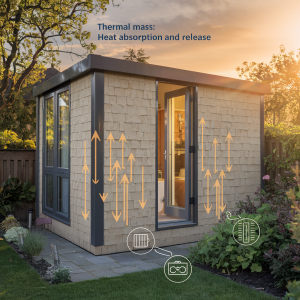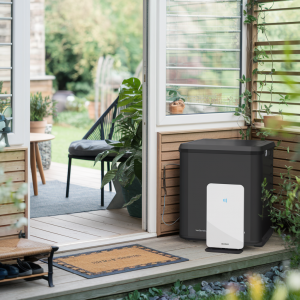It doesn’t take much for the chill to creep into an uninsulated outdoor retreat when the weather turns. Even in a log cabin with thicker walls might not be enough and will lose heat eventually. The good news is, learning how to heat a garden room doesn’t mean starting over. Here’s where to start.
How to Keep a Garden Room Warm
If the cold is putting you off using your garden house,, below are a few simple ways to turn it around:
Check the window insulation
the structure. While most garden rooms are sold with double glazing that reduces the rate of heat transfer by as much as 65%, you might have bought a log cabin that only comes with basic single glazing, leaving it suitable for use only during the warmer months. If that’s the case, you might want to see whether it’s possible to upgrade to double glazing.
If you already have a double glazed garden room, it’s worth inspecting that the seals around the glazing are still functioning. If there is condensation trapped between the panes, that’s the simplest sign that the seals might have blown, which reduces the effectiveness of the insulation. Replacing these panes before the onset of cold weather is a great idea to keep your garden room warm.
Insulate the walls and roof
Note that installing insulation can be considered a modification which could void your building’s warranty if it were to cause any issues.
Heat slips out fast when there’s nothing in the walls or roof to hold it in. Foil-backed boards are an excellent fix for this common problem. These are insulation sheets with a reflective layer that bounces heat back into the room.
Installation is relatively easy, as they can be slotted behind interior panels. You may have to take off the inside wall panel, e.g. timber cladding, to fit the insulation, then reattach it. The same idea applies to the roof if there’s a ceiling panel you can remove. No need to remove the outer walls or structure, or rebuild anything.
See our other insulation guides for different types of garden buildings below:
- How to Insulate a Log Cabin
- How to Insulate a Summer House
- How to Insulate a Garden Shed
- How to Insulate a Garden Office
Add an internal lining (optional)
Assuming insulation is already in place, you can add a finishing layer to boost its effect. This could be a plywood or MDF panel screwed over the top (onto the timber frame) to lock in the heat better. It then doubles the barrier between you and the cold.
Fit underfloor insulation
The floor is often overlooked, but it’s usually one of the main sources of heat loss. This occurs due to cold air rising from below, especially with raised floors or open bases. Rigid insulation boards help block that out and hold more heat inside.
Now, if your floor is already in place, lifting it might not be an option. In that case, consider thick rugs or rubber-backed carpet tiles. They won’t fully insulate, but they do soften the cold coming up through the floor.
Use an electric heater
An electric heater is a quick way to warm up your garden room, and it’s a handy extra if the space is already insulated. We recommend oil-filled radiators and convector heaters. Both give off steady heat, not to mention they’re compact and easy to run.
Place your chosen heater in the middle of the room or close to where you’ll be spending time. Be sure not to wedge it into a corner or push it up against furniture! It’s safer that way, and it helps the heat spread more evenly.
Seal up draughts
Cold always finds its way through the smallest gaps, which often are around the:
- Windows
- Door frame
- Corners
Doors are usually where most of the cold gets in. If yours doesn’t close tightly, adjust the hinges or add a door sweep along the bottom. For the rest, use self-adhesive draught strips to block any openings. Sealant around the edges does the job too.
Note that a small amount of controlled ventilation is still necessary to prevent damp and condensation. If your garden room doesn’t have vents, open the windows a crack during the warmest parts of the day. In some cases it can also help to turn on a fan to boost the airflow for an effective ventilation session.
Round-up
Getting heat into your garden room is one thing; keeping it there is another. Check where it’s getting out, whether it’s the walls, floor, roof, or gaps around the door.
We hope these ideas make it easier to keep your garden room warm and usable all year round! Planning to upgrade in future? This guide should still be useful when the time comes: What to Look for in an Insulated Garden Room



